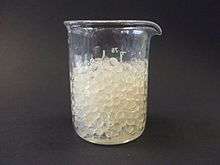Immobilized enzyme

An immobilized enzyme is an enzyme attached to an inert, insoluble material—such as calcium alginate (produced by reacting a mixture of sodium alginate solution and enzyme solution with calcium chloride). This can provide increased resistance to changes in conditions such as pH or temperature. It also lets enzymes be held in place throughout the reaction, following which they are easily separated from the products and may be used again - a far more efficient process and so is widely used in industry for enzyme catalysed reactions. An alternative to enzyme immobilization is whole cell immobilization.[1][2]
Commercial use
Immobilized enzymes are very important for commercial uses as they possess many benefits to the expenses and processes of the reaction of which include:
- Convenience: Minuscule amounts of protein dissolve in the reaction, so workup can be much easier. Upon completion, reaction mixtures typically contain only solvent and reaction products.
- Economy: The immobilized enzyme is easily removed from the reaction making it easy to recycle the biocatalyst. This is particularly useful in processes such as the production of Lactose Free Milk, as the milk can be drained from a container leaving the enzyme (Lactase) inside ready for the next batch.
- Stability: Immobilized enzymes typically have greater thermal and operational stability than the soluble form of the enzyme.[3]
In the past, biological washing powders and detergents contained many proteases and lipases that broke down dirt. However, when the cleaning products contacted human skin, they created allergic reactions. This is why immobilization of enzymes are important, not just economically.
Immobilization of an Enzyme
There are various ways by which one can immobilize an enzyme:
- Affinity-tag binding: Enzymes may be immobilized to a surface, e.g. in a porous material, using non-covalent or covalent Protein tags. This technology has been established for protein purification purposes. This technique is the generally applicable, and can be performed without prior enzyme purification with a pure preparation as the result. Porous glass and derivatives thereof are used, where the porous surface can be adapted in terms of hydrophobicity to suit the enzyme in question.[4]
- Adsorption on glass, alginate beads or matrix: Enzyme is attached to the outside of an inert material. In general, this method is the slowest among those listed here. As adsorption is not a chemical reaction, the active site of the immobilized enzyme may be blocked by the matrix or bead, greatly reducing the activity of the enzyme.
- Entrapment: The enzyme is trapped in insoluble beads or microspheres, such as calcium alginate beads. However, this insoluble substances hinders the arrival of the substrate, and the exit of products.
- Cross-linkage: Enzyme molecules are covalently bonded to each other to create a matrix consisting of almost only enzyme. The reaction ensures that the binding site does not cover the enzyme's active site, the activity of the enzyme is only affected by immobility. However, the inflexibility of the covalent bonds precludes the self-healing properties exhibited by chemoadsorbed self-assembled monolayers. Use of a spacer molecule like poly(ethylene glycol) helps reduce the steric hindrance by the substrate in this case.
- Covalent bond: The enzyme is bound covalentely to an insoluble support (such as silica gel or macroporous polymer beads with epoxide groups). This approach provides the strongest enzyme/support interaction, and so the lowest protein leakage during catalysis.[5]
Immobilization of a Substrate for Enzymatic Reactions
Another widely used application of the immobilization approach together with enzymes has been the enzymatic reactions on immobilized substrates. This approach facilitates the analysis of enzyme activities and mimics the performance of enzymes on e.g. cell walls.[6]
References
- ↑ Zaushitsyna, O.; Berillo, D.; Kirsebom, H.; Mattiasson, B. (2013). "Cryostructured and Crosslinked Viable Cells Forming Monoliths Suitable for Bioreactor Applications". Topics in Catalysis. 57 (5): 339. doi:10.1007/s11244-013-0189-9.
- ↑ Aragão Börner, R.; Zaushitsyna, O.; Berillo, D.; Scaccia, N.; Mattiasson, B.; Kirsebom, H. (2014). "Immobilization of Clostridium acetobutylicum DSM 792 as macroporous aggregates through cryogelation for butanol production". Process Biochemistry. 49: 10. doi:10.1016/j.procbio.2013.09.027.
- ↑ Wu, Hong; Liang, Yanpeng; Shi, Jiafu; Wang, Xiaoli; Yang, Dong; Jiang, Zhongyi (April 2013). "Enhanced stability of catalase covalently immobilized on functionalized titania submicrospheres". Materials Science and Engineering: C. 33 (3): 1438–1445. doi:10.1016/j.msec.2012.12.048.
- ↑ Engelmark Cassimjee, K.; Kadow, M.; Wikmark, Y.; Svedendahl Humble, M.; Rothstein, M. L.; Rothstein, D. M.; Bäckvall, J. -E. (2014). "A general protein purification and immobilization method on controlled porosity glass: Biocatalytic applications". Chemical Communications. 50 (65): 9134. doi:10.1039/C4CC02605E. PMID 24989793.
- ↑ Zucca, Paolo; Sanjust, Enrico (9 September 2014). "Inorganic Materials as Supports for Covalent Enzyme Immobilization: Methods and Mechanisms". Molecules. 19 (9): 14139–14194. doi:10.3390/molecules190914139.
- ↑ Gray, C. J.; Weissenborn, M. J.; Eyers, C. E.; Flitsch, S. L. (2013). "Enzymatic reactions on immobilised substrates". Chemical Society Reviews. 42 (15): 6378. doi:10.1039/C3CS60018A. PMID 23579870.